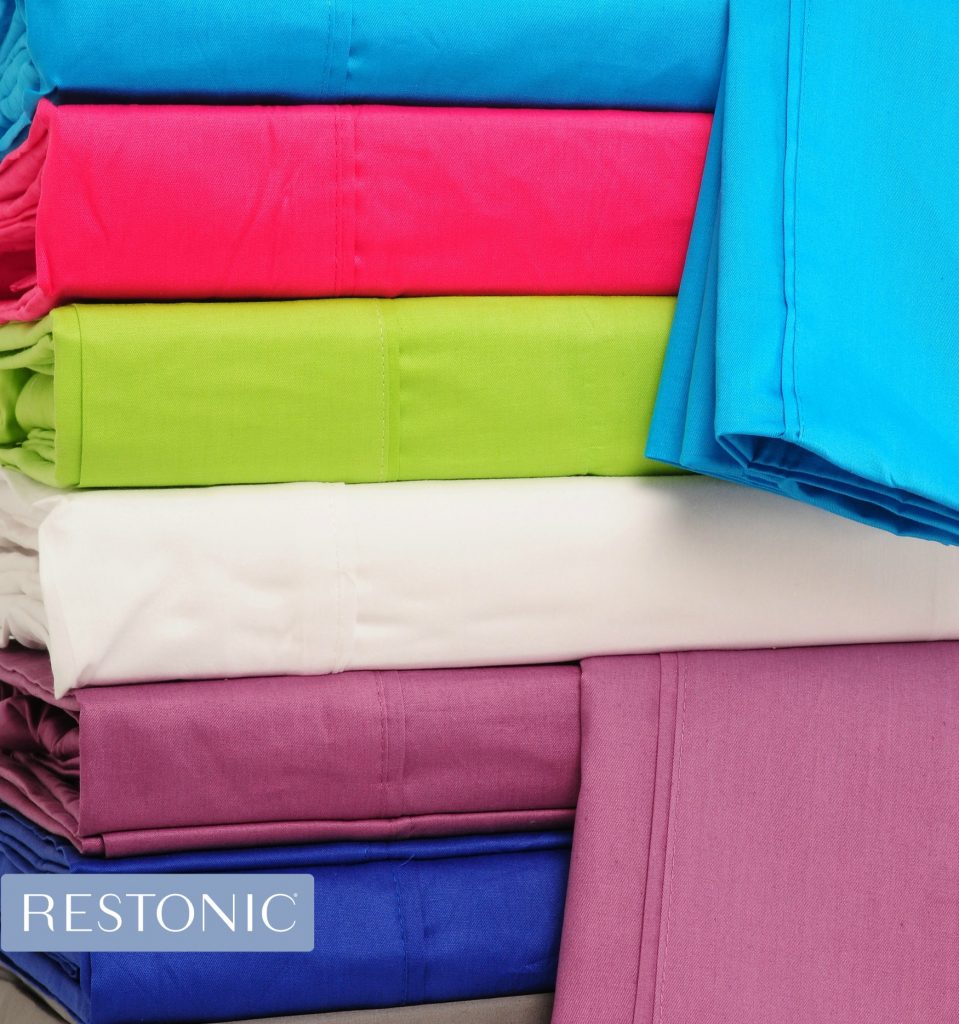 Our tip-filled cheat sheet for sheets to help you sleep better tonight
Our tip-filled cheat sheet for sheets to help you sleep better tonight
Now that you have the perfect mattress, assuming you’re sleeping on a Restonic mattress (which, of course, you are) you’ll want to cover it with the right sheets to create a bed you’ll LOVE sleeping in. With a glut of choices available on the market, it’s easy to feel overwhelmed when it comes to making a decision. Adding to the confusion is a slew of confusing terms spotted on sheet packaging, plus talk of thread counts, fabric types and finishes.
What to look for when shopping for the sheets of your dreams
1. Thread counts of the best sheets. A higher thread count (the number of threads per square inch) isn’t always better. The sweet spot for thread count is between 200 and 400. Higher numbers may be inflated, while not increasing softness or wear – just their price tag. Luxurious feeling sheets may have thread counts less than 400, depending on other factors (see below).
2. Fibers in sheets. Many sheets are a combination of cotton and polyester – a popular choice for those who like a neat, tidy, wrinkle-free look. The blend also appeals to those shopping on a budget. Purchasers are rewarded with great durability since polyester lasts longer than cotton.
 A poly/cotton blend may not be the best choice if you tend to sleep hot since they lack the ability of all-cotton sheets to wick away moisture from you skin. Clammy, damp sheets aren’t fun, so if you’re willing to spend a bit more, look to cotton, which has a soft, cool crisp feel. They also tend to stain less and wash up better.
A poly/cotton blend may not be the best choice if you tend to sleep hot since they lack the ability of all-cotton sheets to wick away moisture from you skin. Clammy, damp sheets aren’t fun, so if you’re willing to spend a bit more, look to cotton, which has a soft, cool crisp feel. They also tend to stain less and wash up better.
If you love smooth, silky feeling sheets, opt for long-fiber cotton, which resist pilling and lint. The key words to look for on the package are “Egyptian-long staple,” Pima” or “Supima” and you’ll find them at the upper end of the scale price scale. Second best is percale, smooth flat and closely woven sheets that may use cotton or a blend. At the low end is muslin with thread counts around 130. They are rough to the touch and are the least expensive of the bunch.
Looking for super-soft sheets? Flannel sheets have a fuzzy, soft feel and can be made of cotton or a blend. They have a brushed nap and are wonderfully warm and cozy, perfect for cold winter night – not steamy humid summer weather. For warmer temperatures, opt for cool, crisp percale or jersey sheets in 100% natural fibers. Sateen sets are lovely, soft and silky, but they’re a bit more delicate than percale and may be prone to pilling and rips. If you go this route, go for better quality and strength in the 300 to 600 threads per square inch range.
 3. Finish/dye of your new sheets. To keep sheets from stretching, wrinkling and losing their shape, most manufacturers use chemicals, like formaldehyde, chloride or silicon. When you take your sheets out of the packaging, you may notice your new sheets are on the stiff side or feel a bit rough to the touch. The chemicals used in the finishing process may be partly responsible. Dyes applied to sheets after they’re made are also a culprit. Washing a few times will help soften them.
3. Finish/dye of your new sheets. To keep sheets from stretching, wrinkling and losing their shape, most manufacturers use chemicals, like formaldehyde, chloride or silicon. When you take your sheets out of the packaging, you may notice your new sheets are on the stiff side or feel a bit rough to the touch. The chemicals used in the finishing process may be partly responsible. Dyes applied to sheets after they’re made are also a culprit. Washing a few times will help soften them.
The other option is splurging on jacquard sheets – the most expensive option. A special loom allows patterns to be woven into the sheets for a more luxurious finish.
If you’re prone to allergies and are sensitive to chemicals, you may want to opt for pure-finish sheets, which forego this finishing process. You might also want to consider organic sheets that are woven with cotton or bamboo (in some cases) and grown without pesticides.
4. Size matters when it comes to sheets. While sheet sizes, whether it’s king, queen, double or twin, are fairly standard, they still may not fit your bed well when you get them home. In the last decade, mattress thicknesses have become more variable, thanks to innovations like pillow tops. Most sheets are fine for a mattress that’s 12 inches thick, but thicker than that, you should be looking for ones with deep pockets. Otherwise, your too-small sheets will be popping off your mattress in the middle of the night.
Check the labels carefully to see what the pocket depth is before buying and avoid sheets with the exact pocket depth as your mattress. For example, you don’t want a pocket depth of 12 inches, if your mattress is the same height. The sheets will simply be too short. Add a couple of inches to take the plushness of your mattress into account. A bit too big is better than too small. You can use sheet clips to secure the fitted sheets, if needed.
You may find the packaging does not mention pocket depth at all. In that case, look for words such as “standard” for mattresses 12 inches high (or deep). For mattresses 13 to 17 inches high, look for “extra deep” pockets. If your mattress is 18 to 25 inches high, you may need help from a sales person to guide your buying decision.
Rest well & wake up ready to go!
Better sleep gives rise to better mornings, bringing your goals into focus and dreams within reach. Hungry for more sleep info? Dig into these posts:
- Where to put your bed for the best night’s sleep
- Better bedroom design with HGTV’s Property Brothers
- Transform your bedroom with good vibrations, thanks to feng shui
Eager for more sleep info you can really use?
Join our community
Facebook
and let's continue the conversation.
We'd love to hear what you have to say!
This blog does not provide medical advice. It is intended for general informational purposes only and does not address individual circumstances. It is not a substitute for professional medical advice, diagnosis or treatment and should not be relied on to make decisions about your health. Never ignore professional medical advice in seeking treatment because of something you have read on Restonic.com. If you think you may have a medical emergency, immediately call your doctor or dial 911.

